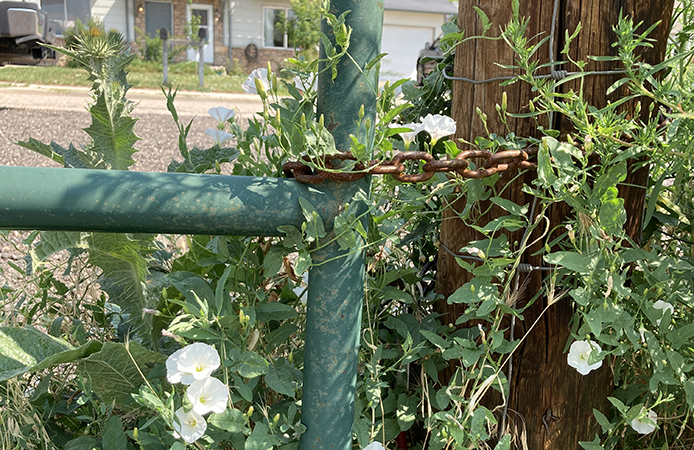Field Bindweed
Field Bindweed
Convolvulus arvensis
Field bindweed is a List C vining perennial in the morning glory family (Convolvulaceae).
Known to be in North America since the 1700s and in Colorado since 1872, it was introduced as a contaminant of seed. It can now be found in all 50 states. It is a native to Eurasia and Asia and naturalized in many other areas.
It has a thick taproot that can grow to 20-30 feet deep and multiple horizontal rhizomeswith buds that form new plants. Plants can easily regrow from root fragments. The root mass can reach 2½ to 5 tons per acre.
The trumpet shaped flowers form in the leaf axis. Flowers form from late spring untilfrost. The 1-inch-wide flowers are white to pink and have two small bracts that form ½ to 2 inches below the flower.
Each flower produces a roundish fruit that contains 2 to 4 seeds. The seeds can stay viable in the soil for 20+ years.
Field bindweed stems are 5+ feet long. They are twisted and are either prostrate or can climb and cover other plants, fences, and structures.
The 2–inch long and 1-inch-wide leaves are alternate, simple and arrow shaped, smallertowards the ends of the stems.
A serious pest in wheat and bean crops, it also invades vineyards, orchards, degraded rangelands, landscaped areas, and lawns. Field bindweed can harbor plant diseases (potato X disease, tomato spotted wilt, and vaccinium false bottom).
Control using cultural techniques and/or systemic herbicides. It requires persistent efforts over multiple years. The bindweed gall mite, Aceria malherbae has shown some good success in areas that are grazed or mowed.
Resources
Pacific Northwest Extension – Field bindweed (PDF)
http://smallgrains.wsu.edu/wp-content/uploads/2013/11/Field-Bindweed.pdf
National Park Service https://www.nps.gov/articles/field-bindweed.htm
Washington State University https://smallgrains.wsu.edu/weed-resources/common-weed-list/field-bindweed/




